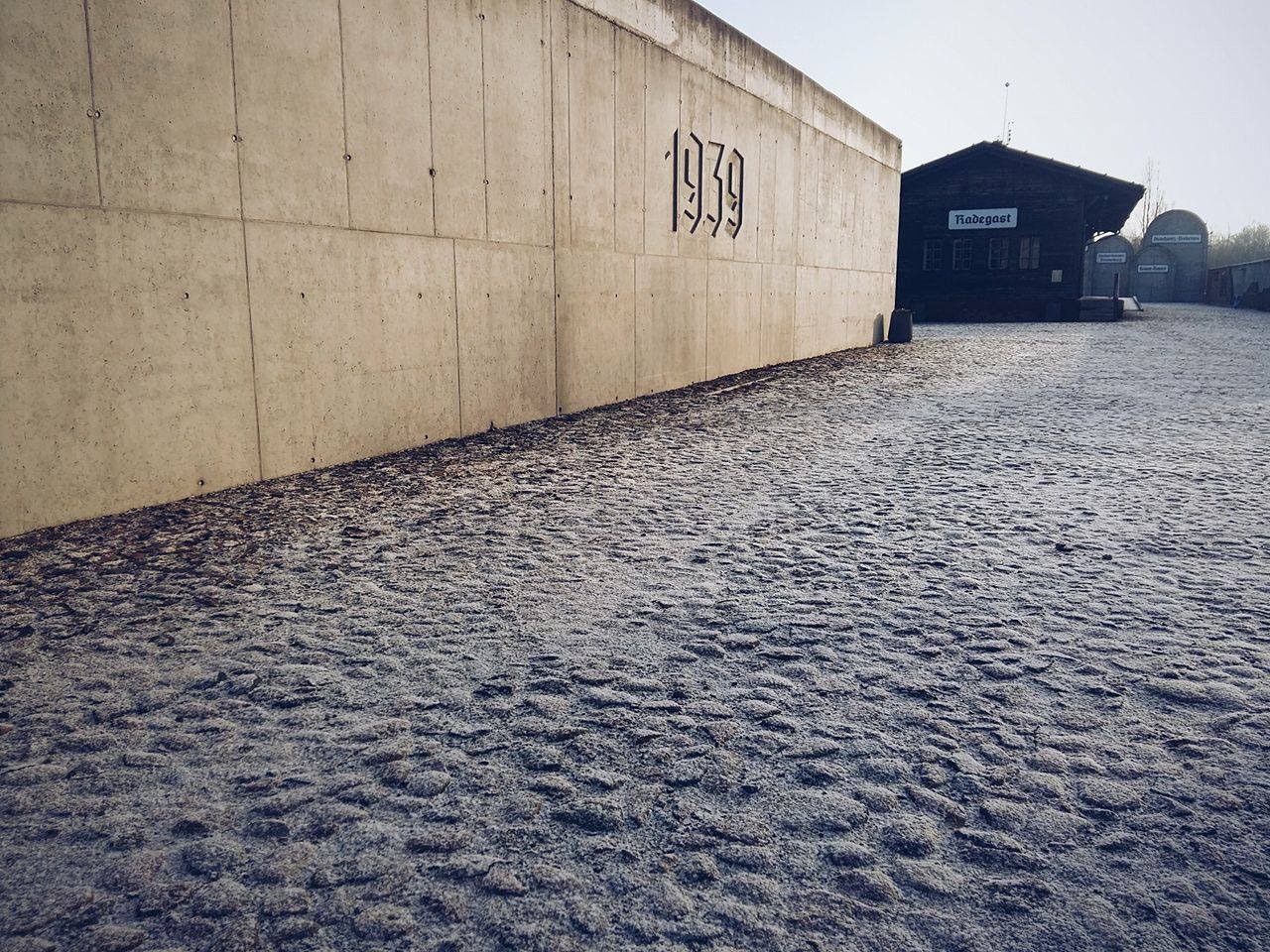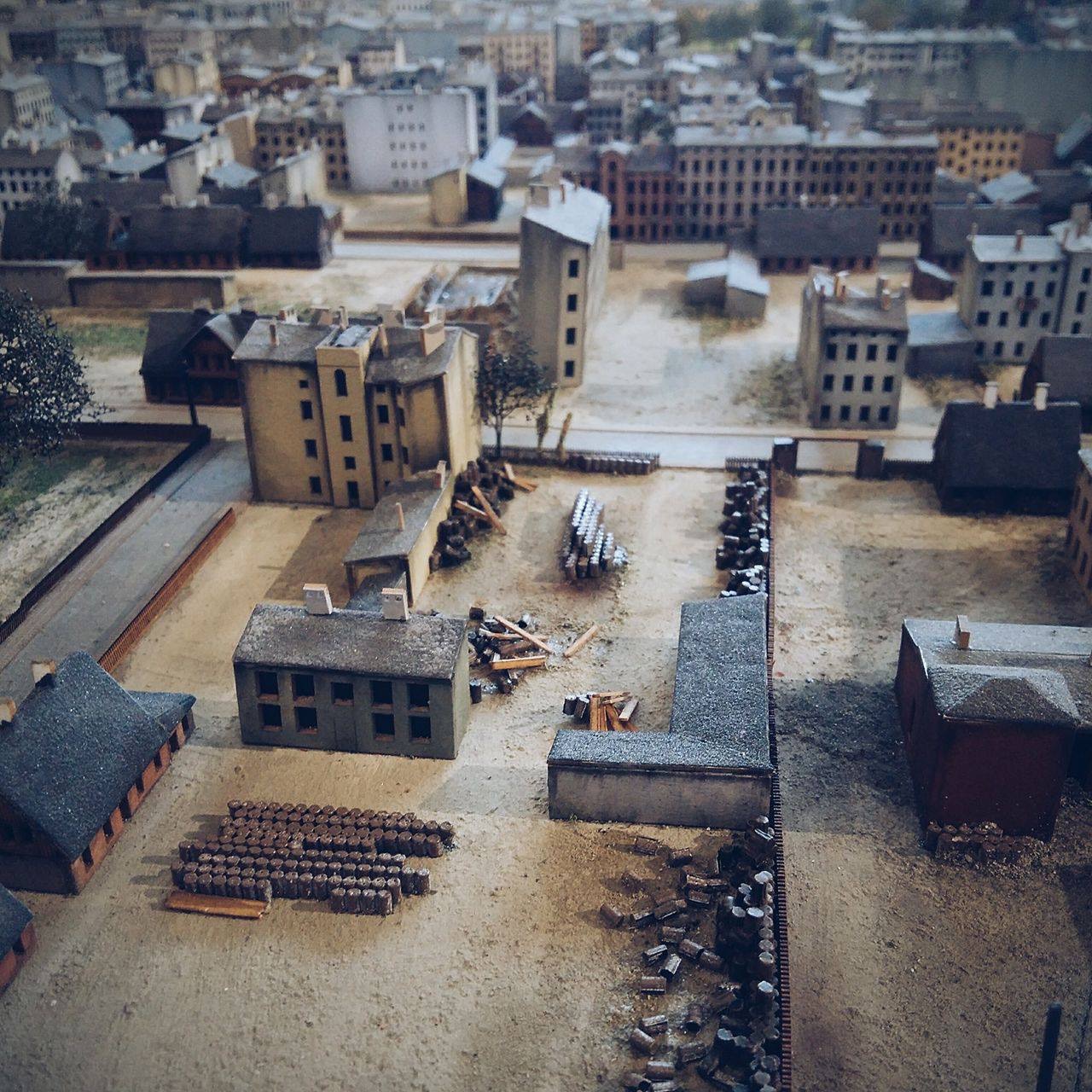Introduction
A New Way to Tell a Story in a Museum
A Historical Model as a Bridge Between Past and Present
Model of Litzmannstadt-Ghetto
The Lodz Ghetto. A Brief History
Technological Innovations in the Service of the Museums
Conclusion
Introduction
“How will future generations remember the Holocaust? Which sources will they use to gain knowledge that will let them create images and formulate concepts related to the tragic past?”1 – asks Janina Bauman, a survivor of the Warsaw Ghetto. By addressing these important questions, she brings up two main problems faced by the researchers, educators and museologists that deal with Holocaust issues – how to talk about this tragic past and how to preserve its memory? In this article, I will use a concrete example to show how this purpose could be achieved with the use of museum exhibition – how to document the past, tell the story and cultivate memory about it. This issue seems particularly relevant in a local Polish context.
Historical museums are important places when it comes to the development of our knowledge about the past.2 It is impossible not to notice that nowadays they are one of the objects of historical debates, even more important in the face of decline in readership in Poland.3 There are continuing disputes about the character and the place of museums in the modern world. They usually focus on exhibition ideas and activities, and alternative forms of education. The purpose of museums becomes the creation of exhibitions that will hold the dialogue with the visitors. While confronting the past with the present, they will affect all of their senses and will not leave them indifferent to the substantive message, becoming an important auxiliary tool in education at the same time.4
This is due to the challenges that museums face in the 21st century and revision of traditional model of museums related to those challenges – the transition from the first-generation museums that only offered a static, organized exhibition and artifacts most often housed in glass display cases (the so-called glass display cabinets museums) to the second-generation museums offering interactive multimedia exhibitions, standing in some opposition to their antecedents.5 In turn, along with the evolution of modern museums, one can speak about the third-generation museums that “stand out by introduction of new exhibition techniques on a large scale, making full use of multimedia and other IT tools and creating an attitude of active participation when it comes to reception of the content offered by the exhibition and study collections in museums.”6
BACK
A New Way to Tell a Story in a Museum
The most expressive manifestations of these transformations are changes of forms and methods of operation, especially the forms and contents of exhibitions. Traditional exhibitions have been replaced by a new model of public exhibitions, characterized by the adoption of an interdisciplinary approach to the problem and introduction of multimedia and interactive solutions. As noted by Krzysztof J. Jakubowski: “The achievements in communication revolution pose entirely new challenges to museums. Sophisticated tools of digital technologies, the Internet and mobile communication networks create previously unattainable possibilities, but also enforce the change of model of operation perpetuated by tradition.”7 This unprecedented development of museums often raises doubts, and even anxiety about these transformations.
What fundamentally distinguishes modern museums from traditional ones is the approach to the recipient that is the reformulation of a previously existing arrangement between the museum and its visitor. Formerly, the visitors remained more or less passive. Nowadays, there has been created a new type of institutions that try to activate them, opening up to the involvement of a wide range of recipients in the processes previously unavailable to them. In this regard, the concept of “participatory museum” by Nina Simon is extremely interesting – museum as the place where the visitors can create, share and connect with each other around content. According to the model of institution proposed by Simon, a passive spectator turns into an active participant – co-creator or co-author. In her opinion, the dynamic development of new technologies caused that the position of passive recipient ceased to satisfy the contemporary visitors, whereas the participatory museum makes the old-type institution a more dynamic and essential place.8 Museums ceased to only store artifacts and tell their story, but became keepers of the historical memory, guarding and speaking about the heritage of the past.
We can distinguish two fundamental types of museums: a traditional narrative museum and an object-centered museum, where the story has been built around available, previously gathered collections and artifacts. There are also so-called mixed museums that combine elements of both these types. When it comes to a narrative museum, a visitor follows a path or paths designated by a museologist. The process of getting to know the past is sort of “programmed” and the possibilities of one’s own interpretation are limited. The second type of museum gives a visitor more freedom. A narrative is no longer linear and brings one to construct a coherent story of the past.
As Anna Ziębińska-Witek observes, nowadays the largest Polish and international museums have adopted narrative forms. Modern institutions provide not only the story based on dry facts, but above all, they create their own vision of the past – just to mention Warsaw Uprising Museum or Silesian Museum. Museums
“can no longer be temples, where the visitors are supposed to contemplate art in silence. Today, they must turn into living, interactive and attractive cultural institutions. That indicates their openness to diverse needs and expectations of the visitors, and evaluation of all the initiatives undertaken from their point of view.”9
Importantly, they often attract visitors that are not interested in layers of information within exhibitions, but in their attractive forms. The high attendance is a sign of a very positive social perception of this type of exhibitions.10 As noted by Roman Batko and Robert Kotowski: “Out of all the cultural institutions in Poland, museums attract the largest number of visitors.”11 In turn, Jean Clair points out that nowadays there is at least a new museum being opened each month.12 What makes this form of presentation, different from a classic story and told only by museum objects themselves, so interesting for today’s visitor? What is its attractiveness about? Does it pose any risks?
Modern multimedia technology is, no doubt, a fundamental factor when it comes to presenting history. Thanks to this technology, it is possible to create an interesting museum even in a small center or in a small space. Why? Using multimedia lets one overcome the problem of too few exhibits and a small exhibition space. Moreover, a proper use of digital technologies significantly enhances the educational process, enriches the exhibition and makes it more attractive. Since the beginning of the 21st century, scientists and museologists have been searching for a new, non-textbook form of a museum education, which would allow the visitors to understand presented issues in a more accessible way than a typical lecture or a school lesson. All the time, researchers are wondering “how to present the relics of the past in a modern way, but to talk about the history in a competent and effective way at the same time.”13
Films, interactive whiteboards, dioramas and historical models (e.g. imitation of a pre-war street in Poland, full of shops and small craft enterprises at the main exhibition in the Museum of the Second World War), belong to the modern means currently used in museums. Small-scale models that faithfully reproduce specific objects (e.g. buildings, factories, bridges) and people figures have become increasingly popular in recent years.
Examples include:
- a model of the so-called ‘lost quarter’ in the Museum of the City of Lodz presented for the first time in 2015 – reconstruction of pre-war buildings, some of them no longer exist, many others were heavily damaged and changed their forms;
- a model of 18th century Praga district in the Museum of Praga in Warsaw that presents the system of roads and urban layout of the right-bank Warsaw districts;
- a model of a baroque city in the Museum of History, a branch of Podlachia Museum in Białystok that presents the city in the times of Jan Klemens Branicki.14
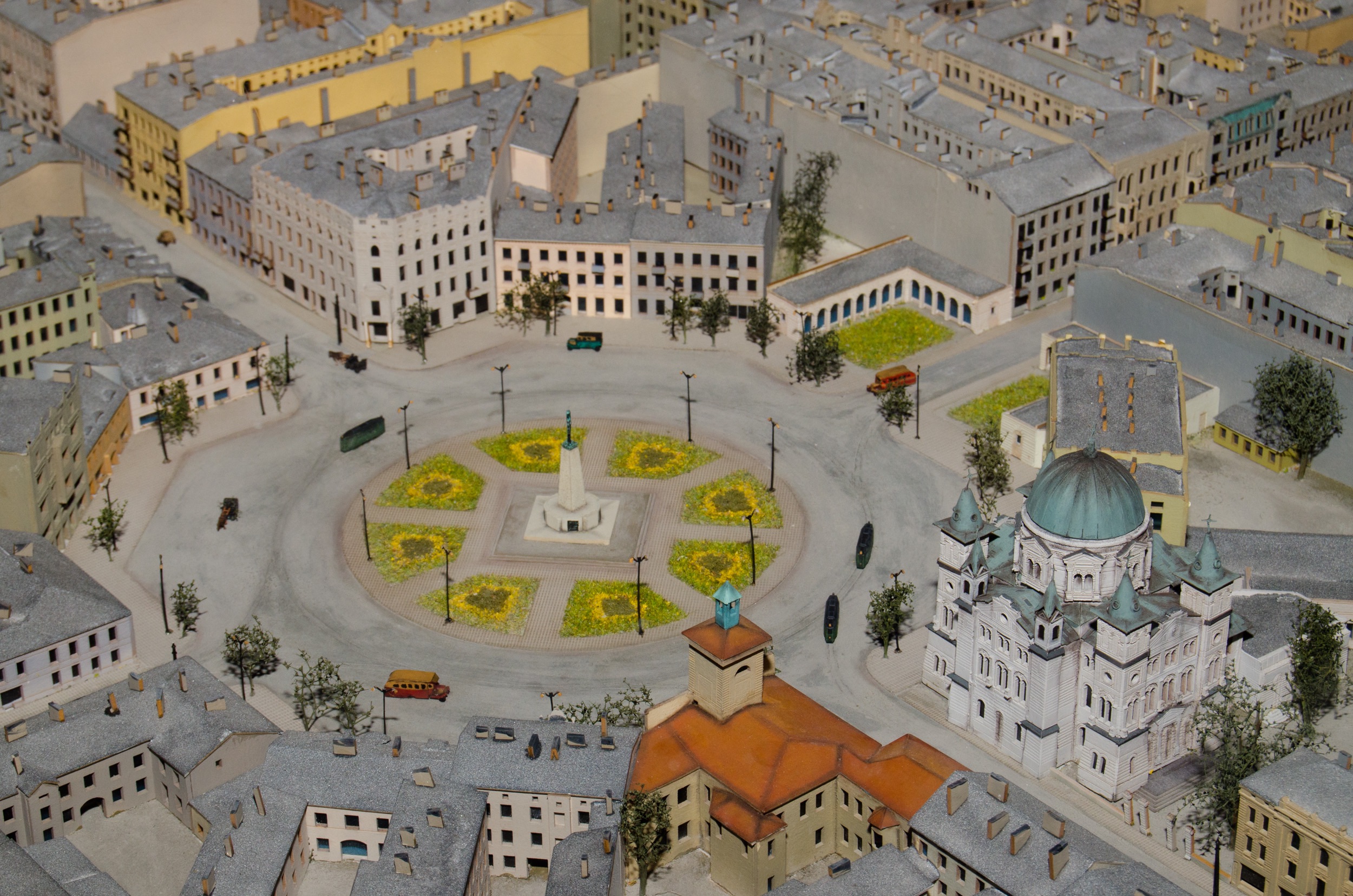
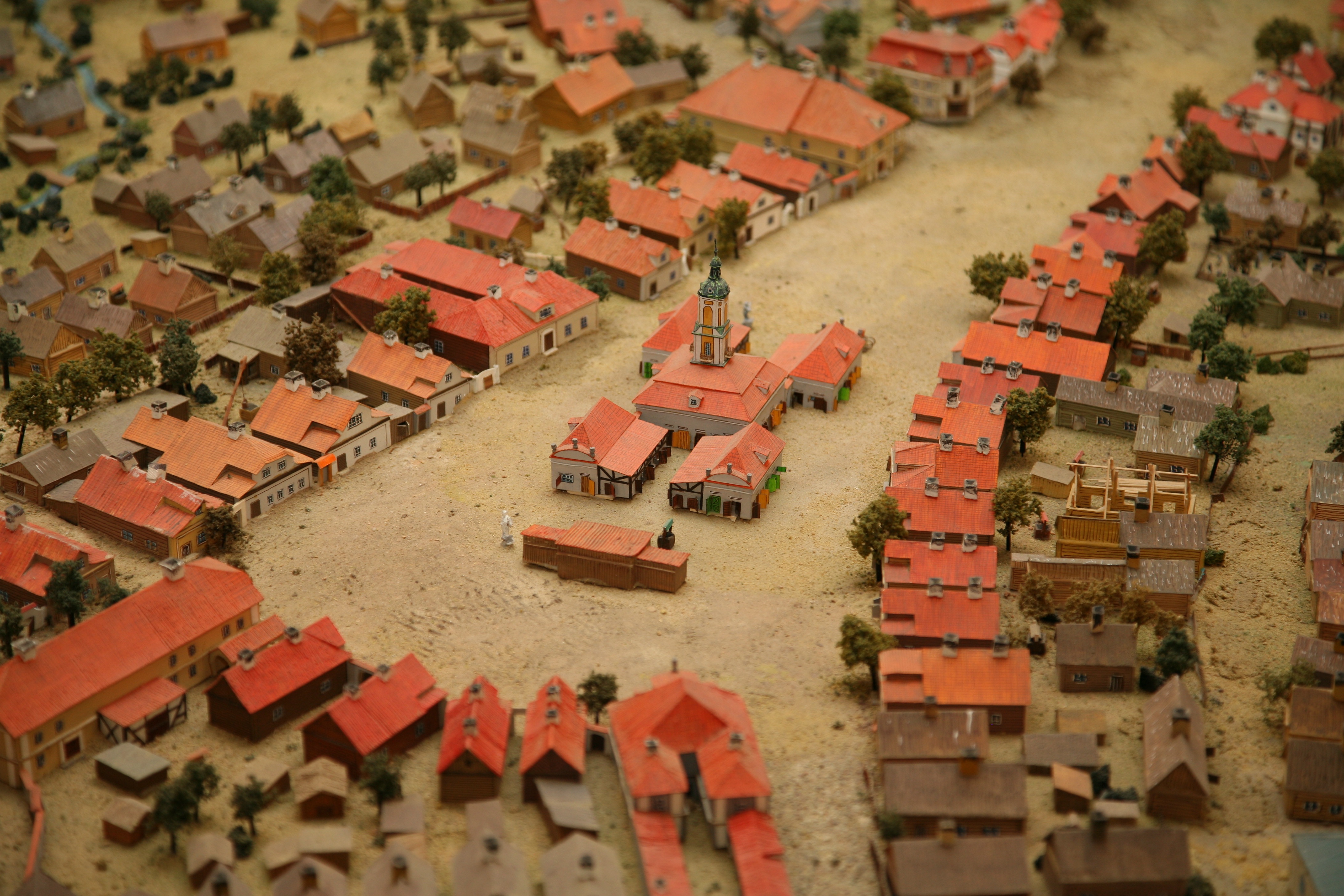
BACK
A Historical Model as a Bridge between Past and Present
The popularity of this modern educational tool should come as no surprise. The models of historical objects tell the story in a very interesting and readable way. Every visitor can easily notice the smallest architectural details – little windows, narrow streets, trees hidden behind the houses and even tiny figures of people long gone. However, not only the models’ attractiveness, but also mainly their effectiveness is well worth considering.
These precise and detailed replicas of the past reality become a valuable source of knowledge and an important tool in the hands of museologists, educators and historians. They can be a part of a larger exhibition or, on the contrary, they can be presented as standalone exhibitions. Of course, it is best if there are complementary elements such as multimedia tools or boards containing additional information. Audio materials can also be helpful. So, one may wonder whether a historical model is an artifact or a narrative of the past. This can be interpreted differently.
On the one hand, scale model is a miniature replica of the specific object – particular building or a group of buildings, but on the other hand, it is also a miniature replica of urban space, where whole building complexes have been reconstructed on the basis of archival sources, mostly photographs, city maps and blueprints, and to a lesser extent on the basis of eyewitness accounts (out of necessity fragmentary and biased).15 This is the case of a previously mentioned model of the ‘lost quarter’ and the case of Litzmannstadt-Ghetto model also located in Lodz, in Radegast Station Museum – a branch of the Museum of the Independence Traditions in Lodz, which was created in the historic station building, serving as the departure place for the Jewish and Gypsy population taken to extermination and concentration camps from January 1942. Today, Radegast Station building is an element of the Annihilation Monument of the Litzmannstadt-Ghetto and a place of remembrance of those tragic events.
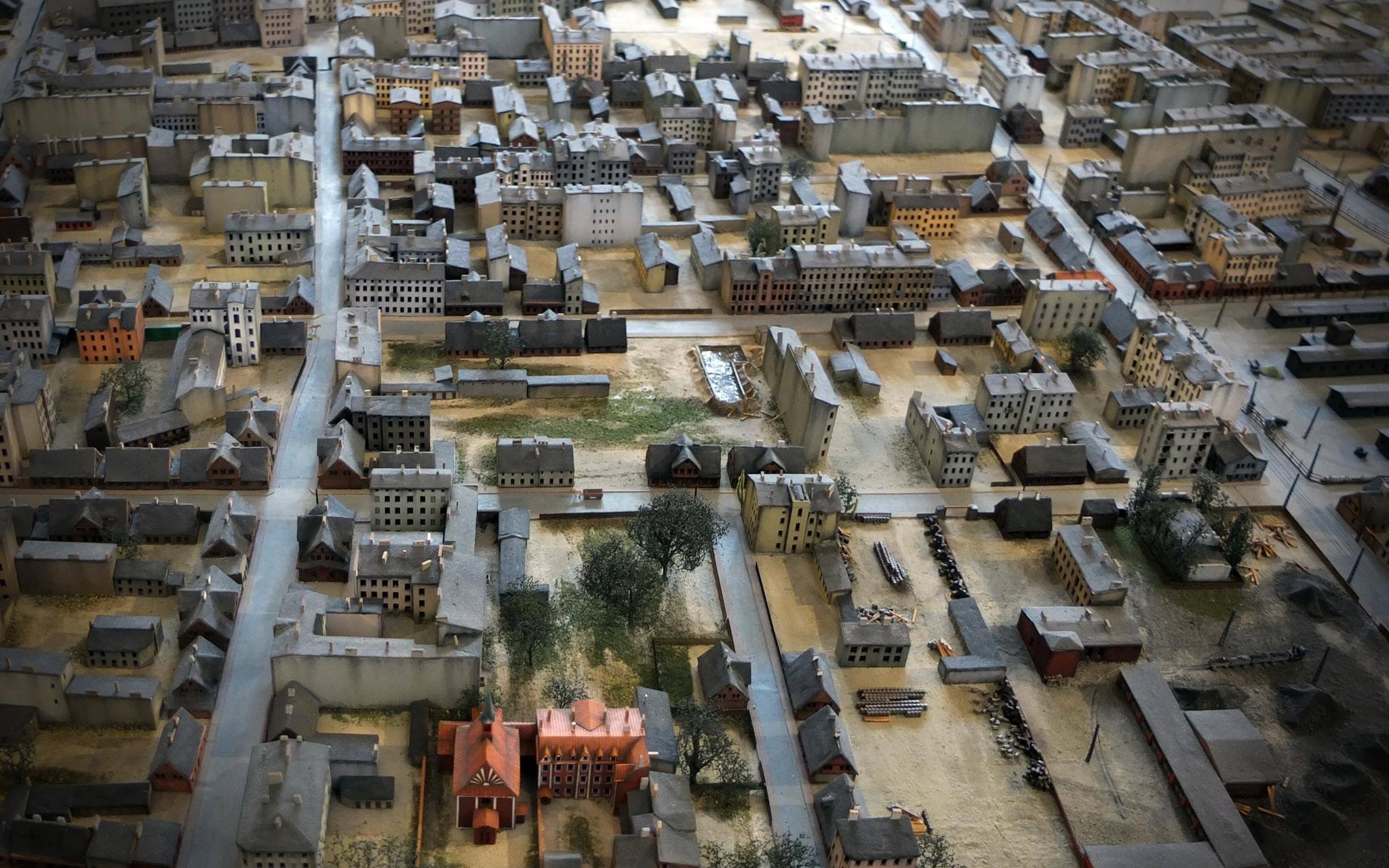
There are also models such as those from Białystok or Warsaw’s Praga that present former times and historical buildings that no longer exist, their full reconstruction was simply impossible. There are, of course, no eyewitnesses alive. Therefore, due to the poor iconographic material, these buildings could only be hypothetically reconstructed. In this case, one deals with a kind of story that appears along with a physical presentation.
Obviously, the way of presenting history through a historical model is not free from defects and limitations. Using such models is particularly problematic in former concentration camps and extermination centers. The need to commemorate these places and to create museums documenting crimes that were committed there was evident since the very first years after the end of the war. In 1958, there was launched the International Auschwitz-Birkenau Memorial Competition for a monument that would commemorate the suffering of the death camp prisoners. Oskar Hansen, Jerzy Jarnuszkiewicz and Julian Pałka were announced as its winners. However, their project of ‘The Road’ Monument was never realized. It turned out to be too radical for the community of survivors, and perhaps for the authorities, too. The authors of the projects proposed that there would be built a wide tarmac road cutting through the former death camp territory.
“That road was supposed to be the only involvement of the artist in the structure of Nazi design and the only place available for people. The camp would be closed and become inaccessible – it would fall into ruin, become overgrown with plants and trees and it would slowly perish over time. The visitors to the site of a death camp could see the object only from that road, without the possibility of entering the area. While walking across the tarmac road, they would cross it along an artificially aligned axis, without ever stepping on its area.”16
Years later Hansen said that the monument was to be “an expression of silence.”’17 Surely, such different idea of presenting the Holocaust must have shocked its recipients, especially those who still remembered the time of war. A decisive objection to such a modernistic presentation of the Holocaust does not seem surprising nowadays, all the more so because works that deal with this subject in a more courageous manner arouse disapproval or even protest also in our times, largely shaped by consumer culture.
So there is nothing strange about similar reactions of people living in the postwar era. Emerging martyrdom museums were lacking prototypes – until then, the purpose of a historical museum was to commemorate positive events in the history of a particular community. In this case the situation was different. Moreover, it was soon realized that a post-camp reality did not speak for itself and its authenticity did not only make things easier, but also caused problems in the transmission of historical knowledge. Nowadays, this problem is becoming more and more clear as the last witnesses of the past events are passing away. For those who have not experienced the tragedy of war, orderly buildings and squares become simply unreadable. On the other hand, the first literal and dramatic exhibits that presented, for example, the tools of torture or striped prison uniforms, however illustrating true horror and being an evidence of the crime, did not have the intended educational effect. There were disbelief and even defensive reactions among the visitors, leading to the relativization of crime or simply its rejection.18 Therefore, the creators of exhibitions in martyrdom museums changed the displays’ character in the following years. They try not to scare the visitors with cruelty anymore. The reality of facts speaks for itself and does not need to be strengthened with additional elements.
Of course, this solution poses risks as well. Clean and renovated building interiors or clean prison uniforms hung on clothes hangers are often unable to reflect the tragic truth about the past events. They usually speak to former prisoners, but they become incomprehensible to the contemporary visitors, thus failing to fulfill an intended educational function.
Yet another problem is the small number of available, pre-existing collections and artifacts. There are not many of them in small museums: deportation lists, fragments of objects found in the former concentration camps, etc. In object-centered museums that often are martyrdom museums, individual stories are hidden behind a piece of broken porcelain, a button excavated from the pits of doom in extermination center or a name on a transport list. One should answer the question whether the first solution does not hide the multitude of killings, and if the second one does not anonymize the victims, showing the enormity of loss with no story behind. It seems that a character of the historical model allows combining both of these issues – it presents a personal fate of an individual on the background of the horrible tragedy that affected millions of people.
Therefore, there is a continuing search to find the best way of teaching the truth about the Holocaust. The basic question is: can this story be told at all? And, if it is so, how should we tell it? What can be shown where there is a very limited space, as is so often the case? What can be presented to the visitors in these places, which were once affected by the most tragic events? Can the story be told only with words? Or should it be told with the use of the objects, which would make a visitor to reach for these objects, touch the place and feel it in a truly tangible way? The number of questions increases all the time. A preparation of the exhibition that speaks to the visitors of all ages and varying degrees of historical awareness is an equally challenging task. Moreover, the Holocaust museums are places of education and they have to be adapted in a way that will let museologists conduct activities with children and youth that expect a historical message to be given in a less traditional and more modern manner, certainly different than a method used at schools.
Additional problems are related to commemoration of the ghettos and not death camps that were most often located outside the cities. After the war, ghettos areas very often became ordinary residential areas – just to mention Muranów district of Warsaw or Bałuty district of Lodz. In today’s urban space, remains of the Second World War such as the remains of the former ghetto are still visible, however the buildings are changed and heavily damaged, and their history is still unknown to many residents, not to mention the visitors. Moreover, survivors and their descendants also look for traces of their ancestors. They search for family stories, but very often are unable to find a location where these stories happened. Hence the idea of restoring the memory of these places by giving them a physical shape. This is the case of Lodz, where the Germans created the ghetto during the Nazi occupation of Poland. It was established in Bałuty – a very poor and neglected district, inhabited mainly by the Jewish community.
“An obscure observer – flaneur – will easily notice that the way a district looks like ‘outside’ does not really reflect its essence. He will see that diverse forms of buildings and their sometimes chaotic locations create a special multilayered tale of the city. Post-war buildings exist next to the 19th century reminiscences, creating a network of cracks that reveal traces of tragic events that happened at this place in the years 1939–1945.”19
After the end of the World War II, a history of these tragic events did not become a part of a collective memory either of the city inhabitants – mostly Poles – or the inhabitants of postwar Bałuty. Nowadays, even the people living in a former ghetto area are not always aware of the tragedies that took place in their houses and their streets, just a few decades ago. As Błażej Ciarkowski observes:
“The memory of the Litzmannstadt-Ghetto is located on the periphery of the communicative memory of a local community. A long-term removal policy has made postwar Bałuty inhabitants build their own identity and a new symbolic space in separation from the history of the place.”20
At the same time, however, Radegast Station Museum – a branch of the Museum of the Independence Traditions – is the city’s second most popular destination after the Lodz Jewish Cemetery for people interested in the history of Jewish Lodz. The activities and events aimed at popularizing knowledge about the history of the Jewish population in Lodz have been taking place since 2005, i.e. since the branch of the Museum was established in a historic warehouse building and a former railway station of the ghetto. Due to the wartime and post-war devastations, there have been changes in this area. Some of them were also related to the necessity of adaption of preserved infrastructure to the museum’s needs (e.g. a given building had only a few original windows). Moreover, the city’s development resulted in the transformation of a landscape around the institution. However, regardless of these modifications, the existing relics give testimony about the history of the Holocaust and continue to play an extremely important role as a medium of the historical message, enabling contemporary recipients to get in touch with events from the past.
BACK
Model of Litzmannstadt-Ghetto
Ten years after, in 2015, the establishment of the branch, the Museum of the Independence Traditions in Lodz undertook implementation of the interdisciplinary project Litzmannstadt-Ghetto Model.21 A static model of the Lodz ghetto, a detailed historical model, is one of its most important elements. It is planned as a new permanent exhibition and an important offer from the Museum for the next years to come.
The project involves the use of modern technology in order to commemorate Jews from Lodz, bring back memories about their fate during World War II. It targets the largest group of people interested in the history of Jewish Lodz, not only in Poland, but also all over the world. The idea was supported by many national and foreign organizations: Archiwum Państwowe w Łodzi, ARGE grenzen erzählen, Centrum Dialogu im. Marka Edelmana w Łodzi, Gedenken-Gestelten, Instytut Tolerancji, Jewish Holocaust Centre, Muzeum Historii Żydów Polskich POLIN, NS-Dokumentationscezentrum, South African Holocaust&Genocide Foundation, Stiftung des Dokumentationsarchivs des Österreichischen Widerstands, Stiftung Topographie des Terrors, Towarzystwo Społeczno-Kulturalne Żydów w Polsce, Związek Byłych Łodzian w Izraelu.22 Moreover, its value has been appreciated by the International Holocaust Remembrance Alliance, which has given it a grant three times,23 including Yehuda Bauer Grant in 2017.
The main aim of the project is to popularize that history in the context of the multicultural and multinational heritage of Lodz. The project is based on interconnected and mutually complementary elements. Within its framework, there is being created a repository of documents and photographs,24 and a static model mentioned above (there are already two fragments of a model and the next one shall be presented in May 2018).
There also exists a website www.radegast.pl, available in four languages (English, Hebrew, German and Polish). The archival materials, mostly photographs, but also documents (e.g. German identity cards – ger. die Ausweise, checkout cards, extracts from registration books, postcards, medical certificates) related to particular individuals are published on the website that consists of several parts – tabs. Particularly noteworthy are those describing the history of the Lodz ghetto. Under the tab titled ‘My stories’ one can find short information about a few people (we shall hope that there will be more of them in the future) and in the section ‘Educational paths’ – posts on issues concerning selected aspects of functioning of the so-called closed district (such as Deportations, Documentation or Childhood). However, it should be emphasized that, despite several years of website’s existence, it still lacks many important subjects that have not yet been presented (e.g. cultural life, religious life in the ghetto, Polish-Jewish relations) or are only briefly mentioned (such as healthcare, education or forced labor). First of all, a small number of biographies on the website can be a surprise. For it seems that the project aims at collecting individual stories that later can be linked to the specific places on the model. A special tab allowing users to add memories, personal data and photographs of ghetto survivors and their families, has been recently launched on the website. Soon, people visiting the Museum will be informed about the possibility of using the mobile version of the website, to which “The Quick Response” codes will immediately redirect users.
Another step aiming at popularization of knowledge about the Litzmannstadt-Ghetto is the creation of a mobile application available for Android and iOS. The application will become a tool that will give users an opportunity to complement knowledge in an effective and interesting way, deviating from the classical methods used to obtain it. What is more important, it allows, in a practical way, access to archival materials and contents at any time, also when museums are closed. Work on the application has just been finished – it is currently available in two languages (Polish and English, though the lack of a German and Hebrew version raises some concerns about the compatibility of the website and a mobile application) and ready for download on the website.
As Piotr Chruścielski writes about the similar project (the application that allows users to learn about the history of Stutthof concentration camp with the use of a tablet):
“With the help of the latest technological solutions and a mobile application that has been created within the framework of the project, he wants to get the stories hidden in a museum space out of the camp relics – the stories about people, events and experiences that redefined the local landscapes not only topographically, but also psychologically and culturally in the years 1939 –1945.”25
A small-scale static model mentioned above recreates an image of the ghetto in May 1942. It does so in the most accurate possible way as the starting point for its creation was a German aerial photograph of the ghetto area. The street network and buildings have been recreated based on this picture. A model is a complete replica of urban infrastructure of that period – streets, squares, residential and commercial buildings, tenements, footbridges, tram lines, wagons, people figures and all the important locations in the ghetto such as departments and offices. The precise appearance of particular buildings (number of floors, colors etc.) has been reconstructed thanks to numerous photographs, urban development plans, city maps as well as the documentation of existing buildings, which have often been preserved in almost unspoiled condition.
The innovation of the project lies in the complementation of a model with three types of multimedia tools – sound, image and light. The subject matter of the exhibition is introduced to users in an interactive way through touch screens. They contain information about the history of the Lodz ghetto and the people who lived there – Jews and Roma communities. The illustration website consists of maps, plans and photographs. A special desktop will allow users to navigate within the site and select available content on their own. They will have at their disposal audio and video recordings attached to especially specified objects and supplemented with a verbal commentary of a historian, as well as archival photographs, fragments of memories or films. There will also be educational paths available, touching upon the most important topics of the ghetto history such as health care, childhood, deportations, and allowing a virtual walk in the ghetto. Users will be able to ‘walk’ down the streets, getting to know the history of the particular places and people who lived there.
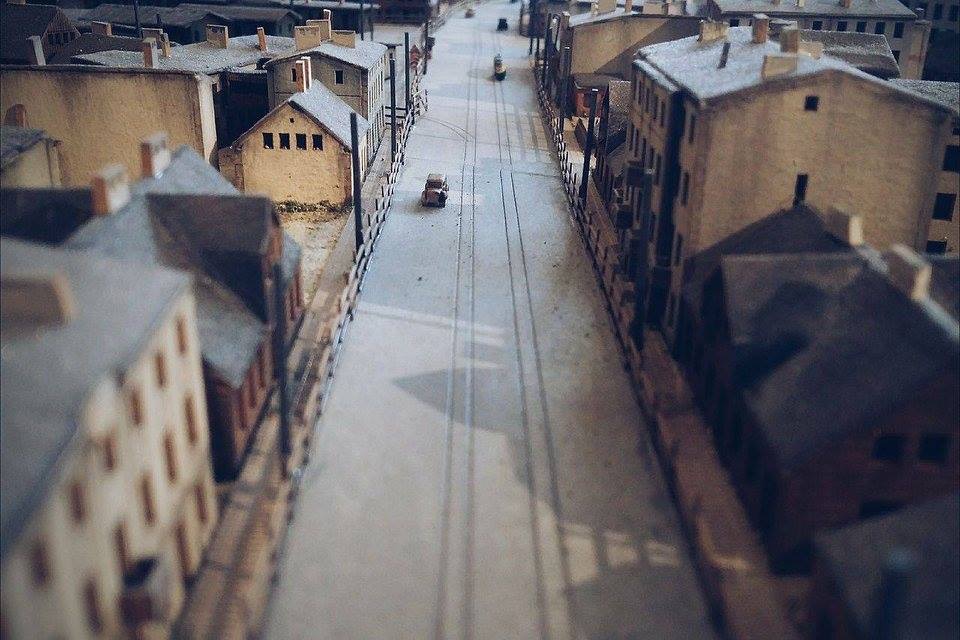
Additionally, an introduction of modern storytelling techniques seems an interesting idea that can be offered to the families of the victims. In this way, they will be able to send their own reports, memoirs and family documents, and gain the opportunity to share these materials with other ghetto survivors, which is no less important. The materials will be added to the already existing historical source database linked with a model. This will offer the relatives a unique opportunity to find unknown information or a picture of their loved ones. Perhaps some photographs or documents, so far stored in human memory, will see the daylight for the first time in many years. Leaving aside the opportunities that are now open for the researchers, this is an exceptional chance to find yet undiscovered traces of a person’s family history. On the one hand, each particular report and individual experience creates a complete image of past times. On the other hand, it makes it possible to get actual people out of the anonymous crowd and show their faces and stories.
It is possible that the relatives will find a mention of their fathers, grandfathers or great-grandfathers, while listening or reading memoirs and reports from the ghetto on a multimedia screen. For the first time, they will also receive a full and comprehensive image of the ghetto – they will see a photograph of a house where their family lived, they will follow their relatives’ road to work on a detailed map, look inside the factory and read a short story of a given place, which later on they will be able to locate on a static model. They will get acquainted with the neighborhood as well as buildings and institutions that were being passed by their mothers, grandmothers and great-grandmothers every day. They will see the places where the important events (e.g. Chaim Mordechai Rumkowski’s – the head of the Council of Elders in the Lodz ghetto – famous speech on September, 1942)26 happened and they will see how these places look right now, after 70 years. The area of a former ghetto and non-existing buildings will be confronted with the contemporary appearance of the district and a postwar urban setting, prompting questions about the content of this space – not only today, but above all, in the past.
A multifaceted narrative, multimedia and nonclassical spatial form are supposed to make the exhibition attractive for everybody – from the youngest spectators that will not be scared with a brutality of exhibits to the oldest visitors. This is “the way to shorten the distance between the past and the present. This is an attempt to understand the history with the use of the latest technologies. It is another dimension of reflection and emotions that accompany the process of getting to know the past. The materialization of the Lost and the Forgotten.”27
BACK
The Lodz Ghetto. A Brief History
The Lodz ghetto, where the Jewish people were relocated and ordered into forced labor, became the longest functioning and the second largest ghetto in Polish lands. It was strictly separated from the rest of the city, surrounded by a wall and guarded by officers of the German Order Police and Jewish Ghetto Police. It even had its own currency – marks, which were called ‘rumkies.’28 More than 200000 people passed through the ghetto during its four years of existence. They were not only Jews from Lodz, but also from provincial ghettos of the Warta Land (including Brzeziny, Łask, Pabianice, Sieradz, Stryków, Wieluń, Włocławek, Zduńska Wola and others) and from abroad (Austria, the Third Reich, Luxembourg or the Protectorate of Bohemia and Moravia). There also functioned the so-called Gypsy Camp29 (Germ., Zigenuerlager) and the preventive camp for Polish children30 (Germ., Polen-Jugendverwahrlager der Sicherheitspolizei in Litzmannstadt) within the borders of the Lodz ghetto. Both of them were strictly separated from the rest of the ghetto.
The ghetto existed from 1940 until 1944. Over 40000 people died of hunger and disease during that time. The others were murdered in extermination centers in Chełmno on Ner and Auschwitz-Birkenau. It is estimated that only 5000 to 7000 Jews were still alive at the end of the war, about 800–900 of whom were survivors of the ghetto.31
The distinguishing feature of the Lodz ghetto was not only the fact of its four-year long-term existence, but also extremely well developed administrative and production apparatus. There were many departments in the ghetto such as the Department of Food and Supplies, the Department of Archives, the Department of Building and Construction, the Department of Housing, the Department of Social Welfare, Postal Division, Public Works Division, Coal Division, the Department of Agriculture, the Department of Statistics, the Department of Transportation and the Department of Health Care Services. There also functioned hospitals, pharmacies, schools, even summer camps for children and the community center, where various concerts and music shows were organized – of course, only until a certain point in time.
The whole activity was documented in thousands of photographs taken by employees of the Department of Archives of the Jewish ghetto administration and, to a lesser extent, by Austrian employee of the Nazi ghetto administration – Walter Genewein – to whom we owe colorful pictures of the occupied Lodz, including ghetto. Additionally, there have been preserved numerous documents of both Jewish and German ghetto administrations, including registration cards, work cards, deportation letters, as well as diaries and personal journals. A primary source material is particularly rich, varied and relatively easy to access. But one must ask the question – how to transfer this knowledge? How to create interest in history? And last but not least, how to preserve the memory of the victims of Nazi policies – the Lodz ghetto prisoners?
BACK
Technological Innovations in the Service of the Museums
“Hermetic, unchangeable organization is not able to meet these expectations. Only an institution oriented to changes that focus on its visitors has a chance to adequately respond to social needs and expectations. However, there are required openness and the provision of high quality services. […] The concern for the audience’s satisfaction is a prerequisite for the success of museum’s activities, which should strive not only for the visitors accustomed to viewing art, but also educate the new ones, including the youngest ones. If a museum wants to attract the audience and shape its attitudes, it must focus on uniqueness, innovation and quality, bearing in mind that a human being is the most important element of these activities.”32
Until recently, education in museums had most often focused on dissemination of knowledge and providing a complement to history lessons at schools. Educational activities were carried out through lectures, publications, exhibition visits, competitions, film screenings or celebrations.
“Pedagogical offers of the museums were directed at transfer and popularization of knowledge, and did not create opportunities for active and critical interaction with history. Although educational activities of Polish museums in the 1970s and 1980s were characterized by a large variety of forms of presentation and popularization, it barely focused on authentic, historical reflection and independent assimilation of historical knowledge. […] The situation did not fundamentally change in the 1990s’”33
as emphasized by Tomasz Kranz, director of the Majdanek State Museum.
At present, technological innovations – oral history, artistic installations and historical models – are important instruments of information and education in the museum space. “New media have become the tools that bring changes to the contact between a researcher-creator and a recipient. They require the latter to be more active.”34 The last form of presentation is already very popular among the museum visitors. Moreover, it is often the only reason that people decide to visit a museum. Then, it is worth asking again: why is this happening? And, above all, why is a historical scale model such an important form of presentation in a historical museum? It is worth taking a look at this particular example – a model of the Lodz ghetto that is being built at Radegast Station Museum.
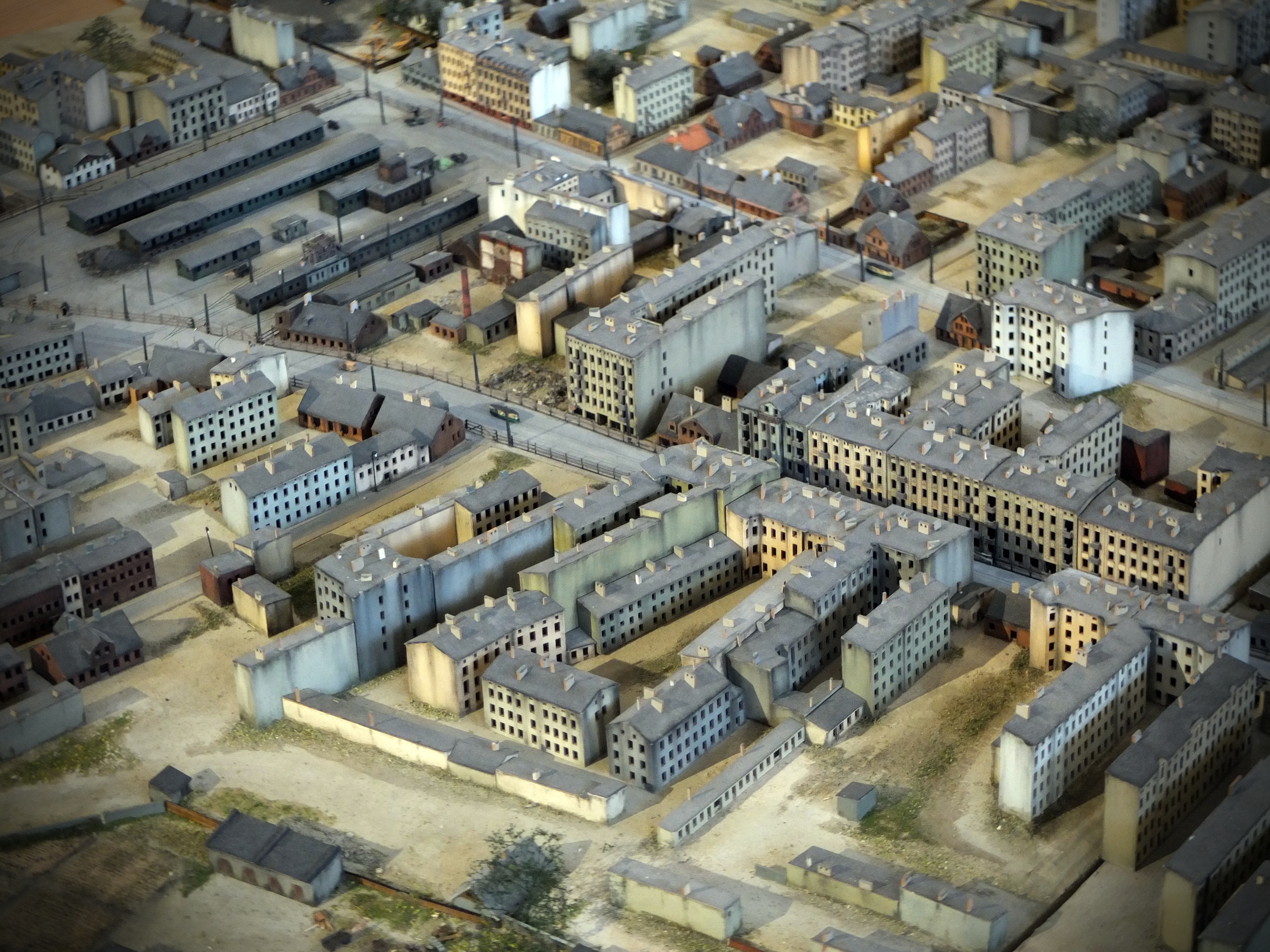
There is still relatively little knowledge about the history of the Lodz ghetto, although it is slowly starting to change. When it comes to studies, historical narratives, popular science and journalistic discourse, one can observe the dominance of the Warsaw ghetto – a heroic ghetto, whose inhabitants resisted their oppressors. The project that is being carried out at Radegast Station provides an opportunity to broaden the circle of people that are interested in the history of the Lodz ghetto and its inhabitants, the history of Jews in general, as well as the history of the city or World War II. A multimedia form is definitely more attractive than a classic description or a typical exhibition, especially for young people. It captures the attention of the visitors, arouses their curiosity and gives museologists an opportunity to reach out to new audiences.
Of course, its primary purpose is to preserve the memory of past events and places associated with them. At the same time, however, a model provides a unique opportunity to visualize a history, thus creating excellent educational and popularization possibilities. Lessons and lectures conducted with the use of specific tools will certainly allow the transfer of knowledge in a more flexible and more complete way. It is not a museum artifact, but a modern object that tells a coherent story. It is supposed to reflect the topographical reality of non-existing or transformed urban space, which would make the visitors realize the enormity of the ghetto and let them clearly define its borders. A model’s creators should use maps, blueprints, area development plans and archival photographs, which subsequently make up the documentation accompanying the model. It also provides excellent opportunities to work with different age groups. Furthermore, a historical model makes it possible to locate a given place in present urban space and tell a story of the place in general, as well as individual stories hidden behind facades of the buildings. With the help of multimedia materials such as photographs, videos and written accounts, a model brings back the memories of places and people. The decreasing number of witnesses of past events makes it especially important to receive their reports and memories, to share them with others and to present them to a wider circle. A chance to take a look at unique photographs owned by survivors and their families, the photographs that are to see the light of day for the first time since the war, is equally important and simply invaluable. Thanks to these personal testimonials, there is a chance to reach out to people who are potentially not interested in history.
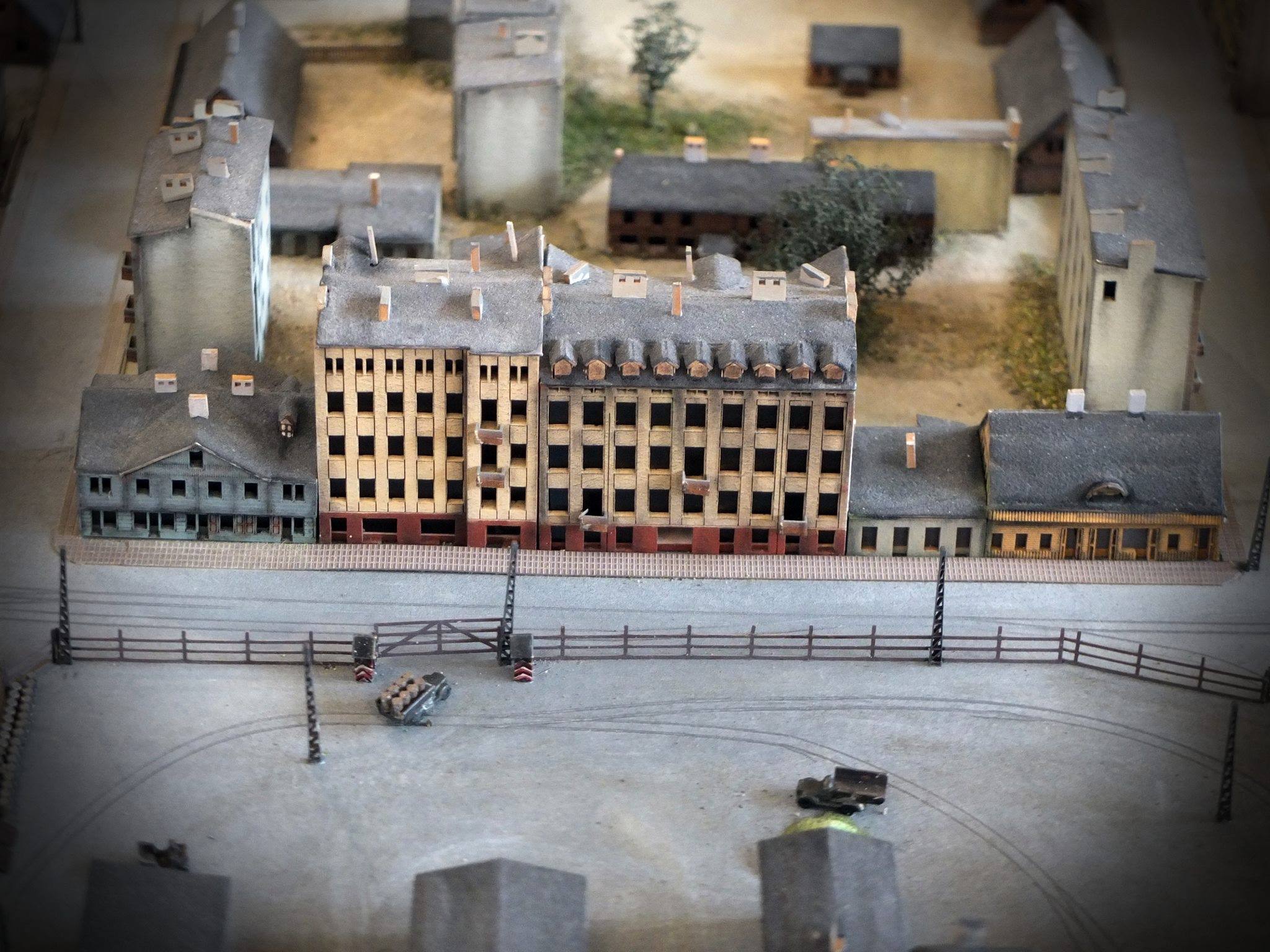
Besides, a historical model is a great tool for overcoming the reluctance of the residents of a former ghetto area and showing them that there are possible other forms of commemoration, rather than erecting new monuments and placing new commemorative plaques on buildings, which often do not fulfill their function. As Frank Ankersmit notices:
“We often see monuments in busy downtown areas, where few things remind us about the person or event commemorated by a monument. As a result of this lack of context, passerby, even if they are aware of the existence of a monument, they probably recognize it as a part of their everyday life, without ever asking questions about a historical figure or an event that a monument commemorates.”35
It is also a good opportunity to engage the local community in the events and activities organized by museums and to deepen understanding of one’s own place and past. Their house or street, in a form of ‘miniature replica’ on the scale model, is easily recognizable. At the same time, however, it is distant and abstract. Nobody tries to turn their house into an open-air museum. It is not their house, but a miniature replica on a model that becomes a reference point in that story of history.
Moreover, anti-Semitism and hostility towards others are becoming more of a problem. It is worth to reflect on what “science and education can tell us about the current growth of extremism, racism, anti-Semitism and xenophobia that pose a threat to democracy, through the history of mankind and genocide.”36 It is obvious that education conducted at a memorial site should put particular emphasis on fighting against any manifestations of racism and xenophobia and concentrate on educating in the spirit of tolerance and democracy. A model as a less invasive form of commemoration can better present the difficult past and encourage reflection on the present. It may start the conversation about the past and the present. It also can become
“an attempt to answer the question how experiences of the others (in this case, dramatic experiences of the victims and the survivors, their resistance and their willingness to survive) can be integrated into educational processes, which in turn should lead to the achievement of the specific didactic and educational purposes.”37
This open form of historical education is still new and thus attractive, especially in Poland. It seems that it is easier to conduct a discussion with its help rather than a help of a textbook or a scientific monograph. Thanks to a well-conducted narrative accompanying a model, the visitors also have the opportunity to learn how to counteract mechanisms leading to the authoritarian regime and as a consequence, to mass murders. In my opinion, putting emphasis on didactic and educational significance of knowledge about crimes of Nazism and shaping attitudes acceptable in democracy is particularly important nowadays.
And last but not least, a model supplemented with aforementioned multimedia tools makes it possible to pass on much more knowledge than a typical exhibition. For new technologies allow providing the visitors with much richer material when it comes to photographs and films, while the access to it is not limited by the physical space of a building or exhibition hall. Moreover, the novelty of both visual and narrative forms of a historical message surprises and arouses curiosity, thus contributing to the awakening and deepening a visitor’s interest in the subjects related to the World War II and the history of the Jewish community. It is extremely important to create the opportunity of making independent choice of information (educational path, a biography of a particular person, a memory of the ghetto survivor) and its presentation on a static model or a multimedia screen. Thanks to that, the visitors can become active participants of the exhibition.
BACK
Conclusion
Undoubtedly, building a historical model of a concentration camp or ghetto may also raise doubts or even serious ethical questions – after all, it recreates a particular space established by the totalitarian regime for extermination purposes. Additionally, it can be criticized because of a non-serious approach towards the history of the Holocaust and the history of Jews during the World War II, or even a superficial interpretation of historical events. The image presented with its help may seem to be poorly informative and simply unclear. There is no place for verification of information or a scientific debate during the visit to the museum. “You may be able to tell interesting, enlightening and plausible historical stories […], but you cannot provide the all-important critical elements of historical discourse – you cannot evaluate sources, make logical arguments, or systematically weigh evidence.”38 And in such situation, there often appear inaccuracies and simplifications. The old reality, precisely reproduced in the museum space, can create a misleading impression that will make the visitors feel that they enter the presented epoch and experience its everyday life. It is undoubtedly attractive, all the more so because learning history comes effortlessly. On the contrary, some visitors may find the image presented through this precise reconstruction unnatural and artificial. That is why it is so important to make such model an element of historical education, to explain its purpose and to develop teaching and learning methods, remembering at the same time that this is a fragmentary and non-subjective image. It is equally important to bear in mind at all times that the purpose of a model is not only to tell the history of the Jewish community and its popularization, but also to preserve the memory about the victims of Nazi crimes.
This is especially significant in the context of the younger visitors, whose attention is drawn by an attractive form that does not require them to have any historical knowledge. The problem is that the subject matter of the exhibition at a memorial site is often abstract, incomprehensible and impossible to imagine for them. While visiting the Radegast Station, one can easily notice that especially children watching the ghetto model, frequently try to touch it. One can even get the impression that they would like to “play” with it. However, it is protected with a special cover and there is no direct access to a model, at least in theory. As noted by Zbigniew Libera: “Having fun and learning are two different things, but of course fun can be educational and education can be provided through fun. However, there can be only one purpose in the case of “game of Holocaust” – prevention.”39 And although this remark refers to the author’s own work – the famous “Lego. The concentration camp” – it seems adequate in the context of the historical model that has become increasingly popular in recent years. The way of conducting a narrative about the Holocaust and, above all, education about it, cannot lead to infantilization and banalization of that story.
In my opinion, a historical model can be an important complement to the museum’s permanent exhibition, and in some cases it can be presented as its central part as well. It is indeed a great educational tool. It allows a visualization of the past in an attractive way, while it remains de facto only its projection (better or worse based on given sources). At the same time, the functioning of the model as a separate museum object raises serious doubts. Every exhibition, narrative or artifact, tries to tell the story. On the contrary, a historical model only shows how the things were or how they could have been. That is why it requires a wider context (e.g. a context of the World War II at European, national and regional level) – it presents no story without the historical background. Therefore, it needs to be complemented by other sources and narratives. It is extremely important that a static model is accompanied by careful textual interpretation on board or tablet screen, as well as the additional catalogue and other materials (leaflets, posters, press releases). The context created by a museum or adjoining exhibitions is no less significant – a historical model cannot be placed among other exhibits that do not correspond to its character or purpose.40 Not to mention the fact that this type of message can be very quickly outdated, because technological progress still creates new possibilities of presentation. One can even indicate example of exhibitions in the Illinois Holocaust Museum, where stories of the Holocaust survivors are presented not only in the form of audio or video recordings, but as interactive holograms.
A previously mentioned model of the so-called ‘lost quarter’ of Lodz, that is, its northern district, presents a fragment of the city from the late 1930s. Why, however, is that area so different from the current one?41 Why did a street layout change? What happened to some of the houses? A static model cannot answer these questions. It is necessary to provide an additional narrative. Only then it will be possible to show how both Nazi and socialist realist planners influenced the presented area, why there is a park on the site of the former congested area and what happened to the pre-war residents of these houses.
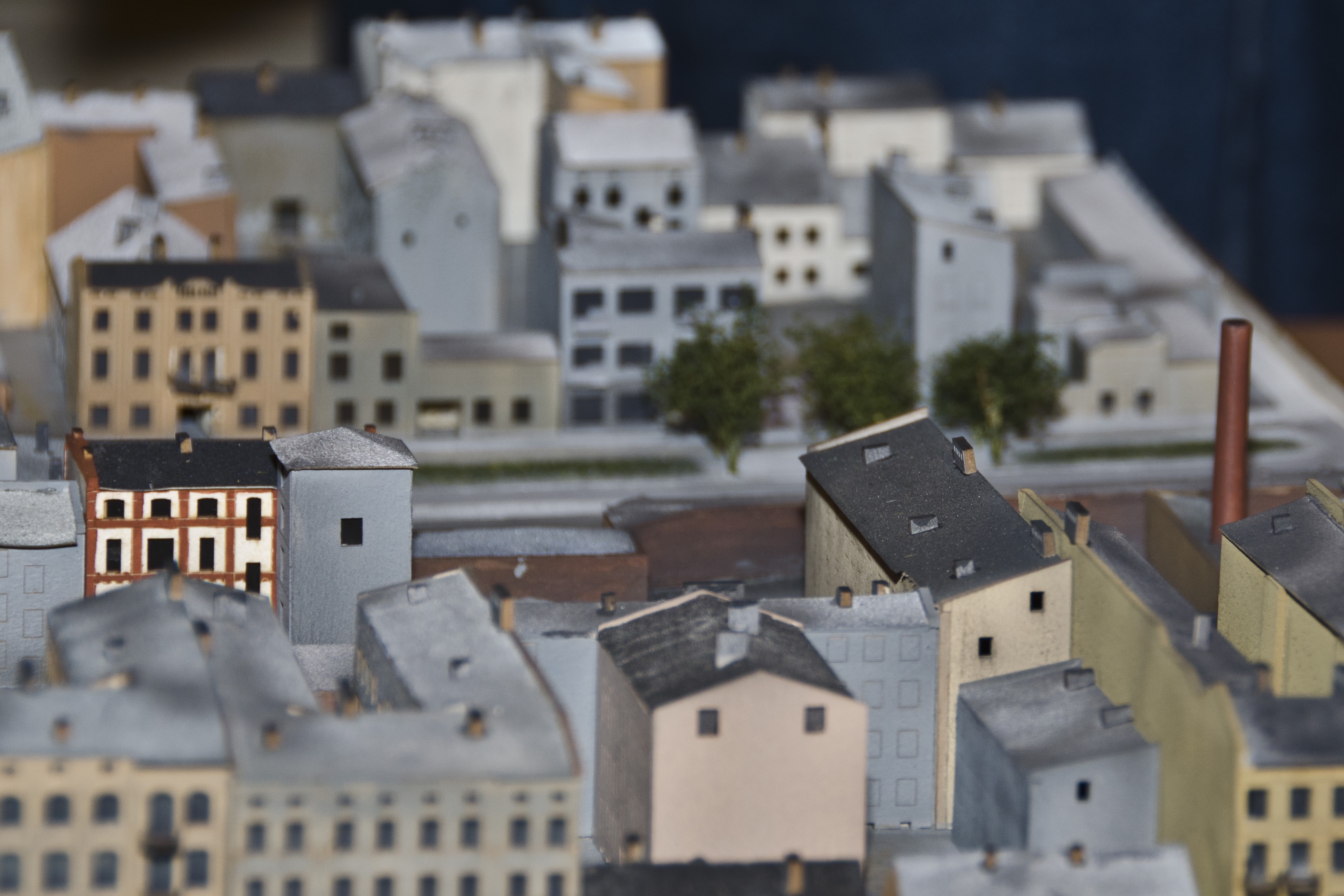
In Poland museological debates focus almost exclusively on a vision of the past that museologists try to present to visitors. I am deeply convinced that the ways of presenting and telling the past are equally worth discussing. The need of using modern means in museums definitely deserves considering. After all, the purpose is not only to tell the story, but also to tell it in an understandable way. “Leaving behind monuments, focusing attention on individual fates of the witnesses of history and using new media open new opportunities to create cultural memory in 21st century,”42 notices Piotr Chruścielski. Certainly, a historical model does not offer ideal solution, especially since we are not accustomed to the way it presents the Holocaust. It seems, however, that adding multimedia components to a model significantly enhances the content provided through that model. Then it becomes something much more than just a static model, responding to the need for multithreaded museum story. It also contains two narratives about the Holocaust – a discourse focused on explaining history and a discourse focused on commemorating history. Perhaps, in today’s world that strongly appreciates attractiveness and accessibility, one has to agree for a more practical approach in presenting history in a modern museum, and as a consequence, for “the acceptance of historical representations as tools […] that work best when one wants to achieve specific goals. They serve our understanding of identity, community and culture better than any other means.”43
